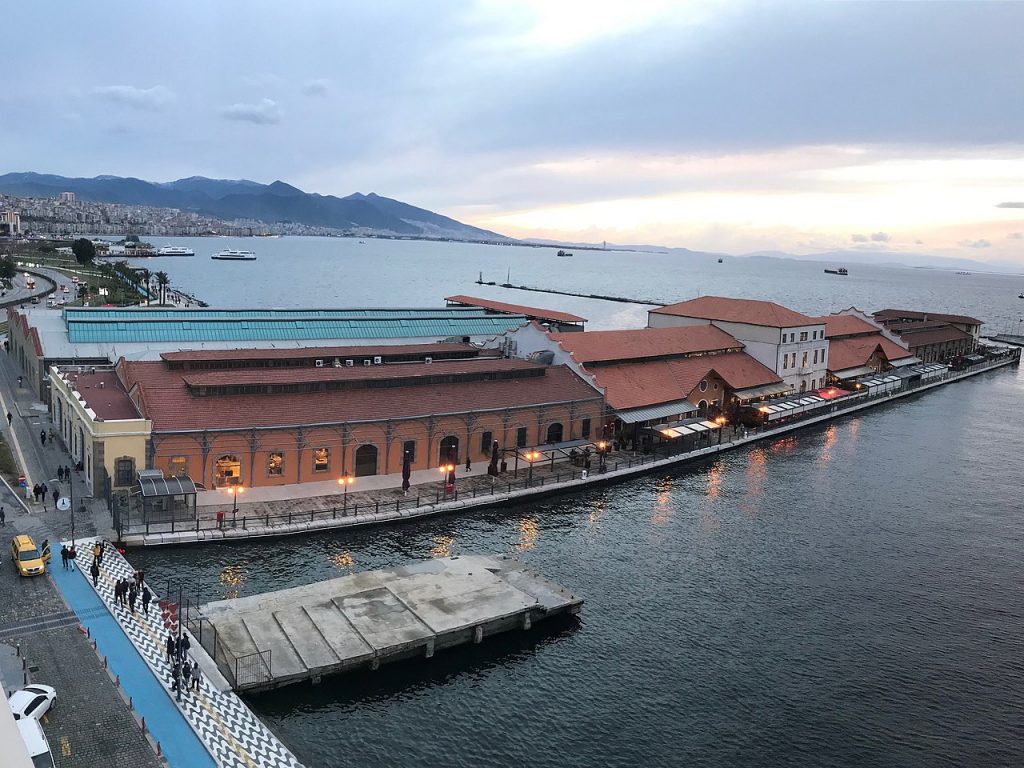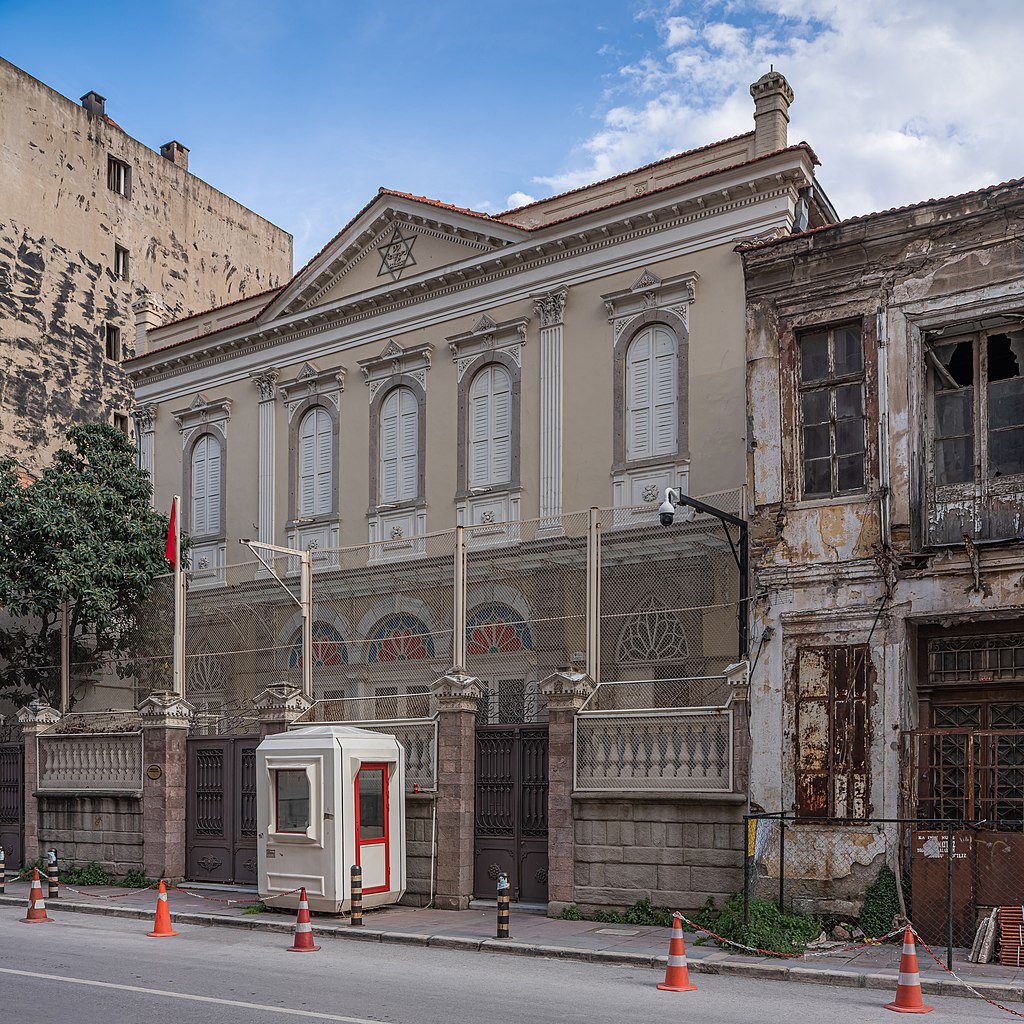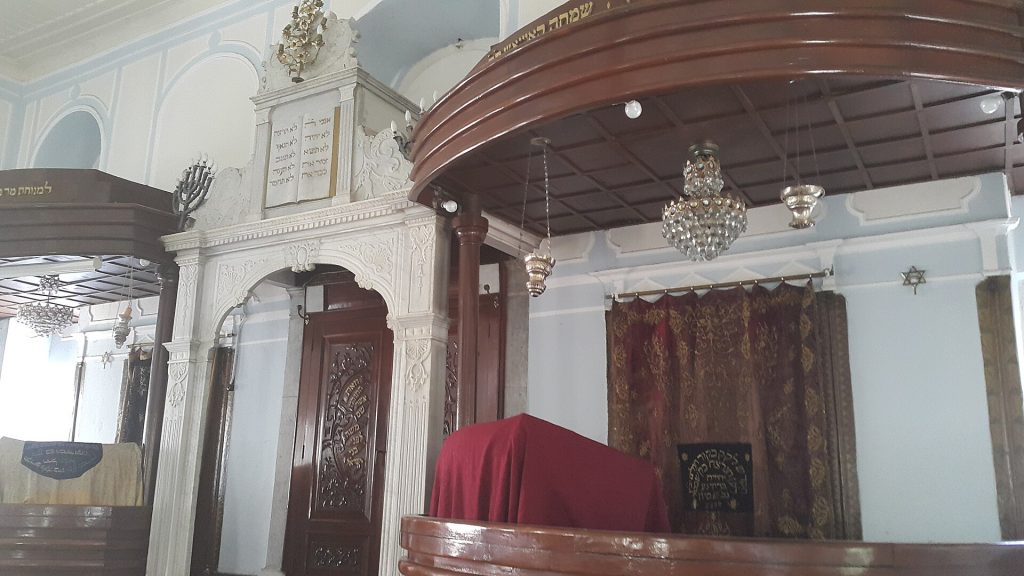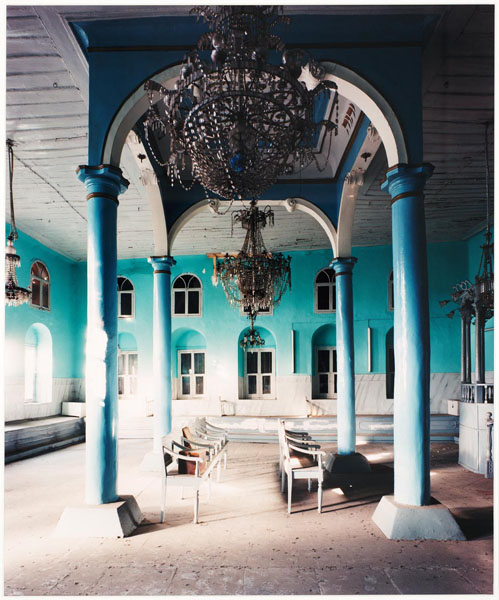
It is unknown how far in the past a Jewish community existed in Izmir. When we speak of the Jews of Izmir, usually the Sephardic Jews who immigrated from Spain and Portugal between 1492 and 1497 come to mind.
However, it has been proven that there was a Jewish settlement in Izmir as soon as the antique age. There is an evidence that a Jewish community existed in Izmir during the Roman Period, while there are as well claims about its existence during the Hellenistic Period. Supposedly, when Alexander reached Jerusalem, he exiled a community of a couple of hundred Jews to Smyrna. According to another claim , in the third century BC Alexander brought Jews with him as he returned from Jerusalem to Smyrna.

There are inscriptions dating back to the second and third century AD which recall of a Jewish presence in Smyrna during the Roman Period. A white stone exhibited at Ashmeleon Museum in Oxford writes, “…..old inhabitants Jews should be given 10.000… (Denari) to open it.”
The First Jewish Settlement in the Ottoman Empire:
According to the Ottoman censuses of 1528 and 1575, the majority of Izmir population was Muslim. There were a few Christians, but a Jewish population was not detected at all. However, two tombstones belonging to Jews dating from 1540 and 1565 were excavated, thus confirming the presence of a Jewish community. Although there are doubts about the existence of the tombstones, the contrary has not been proven yet. In the last quarter of the sixteenth century, for various reasons, Jews immigrated from Salonika, Tsafed and Tire to Izmir. During the sixteenth and seventeenth century Jews of Portugal, Ankara, Patras, Tsafed, Aegean Islands, Eastern Mediterranean cities, even from Italy and from the cities of Western Europe came to Izmir. The presence of the Karait and Ashkenazi Jews in Izmir is also known.
During the Ottoman Period, the first synagogue of the Jewish community in Izmir was “Bakish” (Sason or Eben Kiş) Synagogue founded in 1616-1617. In 1634 there were four synagogues in Izmir. In 1636, the number of the synagogues reached to five, and seven in 1661. After the “Bakish” Synagogue, the following synagogues were built in chronological order: “Pinto” of the Tire Congregation (founded in 1630s or 1640s), “Portuguese” of the Portuguese Congregation (founded in 1630s) and “Neve Shalom”, also of the Portuguese Congregation (founded in 1640s). In 1660 the “Giveret” Synagogue and in 1660s “Algazi” and “Orehim” (Visitors) Synagogues were founded.
The First Jewish Residential Area in Izmir: Ikiçeşmelik (The First Juderia)
The city of Izmir was divided into five districts: Muslim Turk, Armenian, Jewish, Greek and Levantine districts. The Jewish districts in İkiçeşmelik was located between Kadifekale, Basmane and Havra Street, and consisted of Hahambaşı (Chief Rabbi), Efrati, Çavez, Hurşidiye, Yeni (New) Tsontsino and Bene Israel districts. These seven districts were neighbours to Muslim Turk and Armenian districts. Jewish districts were referred to as “The First Juderia.” From the beginning until the last quarter of the nineteenth century, actually until after 1865, when Karataş and its vicinity was zoned for construction, the Jews of Izmir lived in the centre of the city and only in the first Juderia.
The Second Jewish Residential Area in Izmir: Karataş (The Second Juderia)
The Roman walls and just behind it the Antique Jewish Cemetery constituted the south border of the city of Izmir. This cemetery referred to as Maşatlık, was the oldest cemetery of Izmir Jewry until it was completely removed in 1926. In 1865, the land beyond the Jewish Cemetery was zoned for construction. The Jewish population in and near Karataş started to increase rapidly. Jewish temples and schools were built. The wealthy Jews living in the first Juderia moved to the separate houses built in and around Karataş. “Yahudihane” (Jewish houses for the poor Jewish families) were also built in the district. Eventually, the second Juderia of Izmir was built here. At last, while the first Juderia was used for the Jewish districts in İkiçeşmelik, the Second Juderia became the Jewish districts of Karataş, Göztepe and Karantina.

The Regression Period of Izmir Jews
With the ongoing emigration, the Jews who came from Spain became a majority in Izmir; and grew stronger with the privileged positions they gained in the administrative staff and in the business sector.
In the second half of the eighteenth century, socially and politically, Jewish people plunged into a deep darkness. Serious financial distress aroused in the Jewish communities of Istanbul, Izmir and Salonika.
The authority of the Rabbis strengthened and as the religious authority strengthened, the educational system based on scholasticism gained importance and the Jewish people were deprived of the modern educational system. In time, Jews lost their privileged positions in the business sector and the administrative staff to the Greeks and Armenians who were protected by Western countries.

Between 1922 and 1948 the Jews of Izmir immigrated to foreign countries. With internal migration the population of the Jewish Community of Izmir had risen to 55,000 in 1922. This population began to decrease because of the immigrations to Western countries, especially to South America. Between 1921 and 1929 the number of Jews who departed from Anatolia was nearly 70,000. The young generation started to go to Palestine by legal or illegal means. After the Establishment of the State of Israel, the population of the Jews in Izmir was brought down to 3,000. The years of 1940s and 50s was the period when the Jewish Community of Izmir sent the poor population mainly to Israel or to the outskirts of the city. Thus the Jewish colony that stayed in the city decreased in number, but on the other hand gradually became a refined society composed of families of high social and economic status.
A festival featuring concerts of Jewish and Ladino music, tastings of traditional dishes and lectures on Izmir’s Jewish community was organised in 2023. In 2025, just over a thousand Jews will live in Izmir.
Ikiçesmelik (the first juderia)
Bikur Holim Synagogue
The synagogue was founded by a Dutch-descent, Salomon de Ciaves. In the eighteenth century, a part of it served as a clinic during the plague epidemic. The great fire of 1772 that ravished Izmir destroyed the synagogue and to replace the old one a new synagogue was built by Manuel de Ciaves in 1800. The synagogue which still preserves its original appearance, is in the Konak district, in İkiçeşmelik, No. 40.
Portuguese Synagogue
It is presumed that this synagogue was founded by Portuguese emigrants in the 1630s. This was the second synagogue built in Izmir during the Ottoman Period. Due to fires and earthquakes, the Portuguese Synagogue was destroyed several times and was rebuilt. It is presumed that the synagogue, as it stands today, was rebuilt in the nineteenth century. The synagogue faced a severe fire danger in 1976 and the building is still being restored. The synagogue is on 920 Sokak, close to the Rabbinate in Kemeraltı. Numerous sources assert that in 1666 the Portuguese Synagogue was the centre of the events related to Sabbatai Tzvi.
Neve Shalom (Shalom) Synagogue
Neve Shalom Synagogue, also known as Shalom Synagogue, was founded in the first half of the seventeenth century by wealthy Portugese conversos (converts). Among the chief Rabbis of the synagogue were the famous scholars Rabbi Yosef Eskapa and Rabbi Aharon Lepapa. An inscription inside the courtyard, right next to the main entrance of the synagogue, refers to the great fire of Izmir in 1841. The great fire of Izmir, which broke out in June 1841, burnt down many synagogues and destroyed the Jewish quarter, leaving thousands homeless. The tragic event was to be remembered for years as a devastating calamity. It is said that the flames miraculously died out, right in front of the main entrance of the Shalom Synagogue. Hence, the synagogue survived with no damage. The marble stone inscription depicts this miracle.
Ashkenazi Synagogue
The synagogue was likely built around the nineteenth century. It used to be adjacent to Neve Shalom Synagogue but it no longer exists today. When you enter the gate of Neve Shalom Synagogue, on the left wall of the courtyard, you see a tablet installed as a reminder of the Ashkenazi Synagogue, which ceased to exist.
Algazi Synagogue
Synagogues built in Izmir were usually named after either the name of the principal founder or the ruling governor of the synagogue. Algazi Synagogue was likely founded by the Algazi family around 1660s. The synagogue has recently been closed.
Mahazikei Torah (Tsontsin – Sonsino) Synagogue
The Mahazikei Torah Synagogue was built in the nineteenth century, along with the Talmud Torah (Hevra) and Beit Hillel synagogues. The architectural style and the dome of Hisar Mosque were taken as models during the construction. The synagogue underwent two major construction phases in 1850 and 1896. The building is today almost in ruins. The four pillars supporting the tevah and the four walls are the only visible remains of the old synagogue. It stands on İkiçeşmelik district, at the corner of 826 Sokak and 821 Sokak.
Schonsol Synagogue
Donated by Hayim Shemuel Shonsol, a structure located in Basmane Aya Vukla district opened its doors to serve as a synagogue in 1909. The two-story synagogue, housed a 12-roomed cortijo on the first floor and a temple on the upper floor. The synagogue was burnt in a fire around 1970s and it underwent a major repair. Later on, ıt was used as a car washing facility. Owned by the Izmir Jewish Community, the property is currently vacant and not used.
Talmud Torah (Hevra) Synagogue
Talmud Torah Synagogue was built in the nineteenth century. In most of the synagogues in Izmir, the traditional architectural style included a Bet Midrash (House of Study or Medresa) or a Yeshiva, located usually in the foyer. Structured in accordance with this general characteristic, Talmud Torah had a Bet Midrash as well. The synagogue laid in ruins for a while before being definitively closed.
Beit Hillel Synagogue
The Beit Hillel Synagogue was founded by Eliezer Hillel Behor (Behar) Menuah to serve as a yeshiva in the first quarter of the nineteenth century. It is likely that the original structure had been divided into two parts: The main area (the Beit Midrash or Yeshiva) located on the left side and the Rabbi’s House (İkâmethane in Turkish) on the right. The left part was used as a synagogue in the following years. The Ehal wall is set into the central sanctuary on the southern wall, and the Tevah is located on the opposite side and is adjacent to the north wall, facing the Ehal. It was burnt down to ashes in a fire in 2006. The roof has also collapsed during the fire. The Izmir Metropolitan Municipality started a rehabilitation plan for the historic Agora site and the synagogues, aiming at connecting these neigborhoods to the Kemeraltı Bazaar. It has employed workers and provided equipment for this purpose. In the same year, a major reconstruction work has started at Beit Hilel Synagogue and its restoration was completed in 2015. The synagogue is now modified to “Rabbi Palacci Memorial House”, where all notable documents and photographs are on display. It reopened its doors on April 27, 2017. The synagogue is located in Ufuk Mahallesi, on 920 Sokak, No 23.
Ashkamat Beit HaKnesset
Ashkamat is an approximately 50 square meters small synagogue. Its exact date of construction is unknown. It is likely that the synagogue was originally a private residential building that was converted to a synagogue. The synagogue is not active today. Owned by the Izmir Jewish Community, the property is currently used as a storehouse. Located on İkiçeşmelik, 834 sokak, No. 46.
Senyora (Giveret) Synagogue
Heavily damaged by the great fire of Izmir in 1841, the synagogue was restored again based on a central plan, with the financial support of Yerushalmi family. The main area of the synagogue is reached by a terrace elevated by five stairs from the courtyard. It was originally a centrally-planned synagogue. However, the Italian architectural style, which started to become the major influential factor in the architecture of synagogues in the twentieth-century, was adopted in the Senyora (Giveret) Synagogue at the time of its reconstruction. In the new architectural plan, the formerly portable tevah became fixed in the Ekhal wall with the Torah arks. A linear type of seating arrangement, as found in churches, was adopted. The ezrat nashim, which is on the second floor right above the entrance hall that leads to the sanctuary, is reached by the stairs located in the courtyard. The synagogue is located in a wide courtyard and is hidden behind high courtyard walls. The Senyora (Giveret) Synagogue stands on Havra Sokağı, with façades along the Anafartalar Caddesi and 927 Sokak.
Etz Hayim Synagogue:
“Etz Hayim” means Tree of Life in Hebrew. The synagogue is said to be built in the Byzantian period, but there is no evidence to support the claim. The synagogue was burnt during the great fire of Izmir in 1841, but it was rebuilt again with the contributions of Daniel Sidi in 1851. The synagogue is located in Akdeniz Mahallesi on İki Çeşmelik Caddesi, No.5. The synagogue building needs restoration.
The Old Rabbinical House
It is also known as the community house. It was presumably built in the nineteenth century as the Rabbinate building. It was later used as an archive for many years to document community records. For many years, it has been used as an archive, where community records were kept. Today, it is in a poor condition, almost collapsing in ruins.
The Sabbatai Tzvi’s House
The house was formerly located within the boundaries of the old Bene Israel neighborhood in İkiçeşmelik, but it now lies within the Smyrna Agora excavation area. Carried out under the supervision of the Izmir Metropolitan Municipality, the restoration works is still in hand. The house has not yet opened its doors to visitors and can only be seen from outside.
Karatas (second Juderia):
Beit Israel Synagogue
The Beit Israel Synagogue , on Mithat Paşa Caddesi right on the tram road, is the largest synagogue in Izmir. Its construction started in 1905 and it began holding services in 1907, despite the ongoing construction. It is a two-story structure, where the lower floor is reserved for men and the upper floor for women. Compared to other traditional Jewish temples in Turkey, it has a distinctive architectural style and a unique sitting arrangement. In the traditional architectural layout, while Ehal Akodesh is often situated on the eastern side of the interior, Beit Israel is mostly on the south end. In the original architectural plan, it was intended to top the entire ceiling with a dome, but the limited financial resources permitted building only a small central dome. Aside from the common traditional and religious Jewish motifs, symbols of the Turkish state are used in the interior as well. The seventh center stem of the seven-branched bronze Menorahs inside the synagogue is replaced with “a star and a crescent”. A room towards the eastern side of the interior is organised to serve as a yeshiva. At the top, on the right-hand side of the front entrance is written 5668 (1908), the opening date of the synagogue, and on the left-hand, Shaddai, one of the names of God to describe His self-existence. Located in Turgut Reis Mahallesi on Mithatpaşa Caddesi, No. 265.
Rosh Ha-Har Synagogue
The Rosh Ha-Har Synagogue was presumably built in Karataş between the years 1890 and 1895. In 1906, it underwent a major repair. The building’s main entrance is accessed by a three steps up into a small garden courtyard. The synagogue is based on a central plan. On an axis with the main entrance, a terrace reached by twelve steps from the garden, leads directly into sanctuary. Located on the 281 Sokak in Yukarı Karataş.
Karataş Jewish Hospital
Nesim Levi Bayraklı donated his house to be used as a hospital after Rothschild Hospital located in İkiçeşmelik closed down. The institution was officially recognized as a hospital by Sultan Resat himself in 1914. Karataş Hospital continued to operate as a foundation under the name, “Izmir Jewish Hospital Foundation” until 1926. It is today a medical center.
Karsiyaka
Kahal Kadosh Synagogue
The Kahal Kadosh Synagogue was founded in Alaybey between the years 1881 and 1882 to meet the worshipping needs of the Jewish community who moved to the Karşıyaka district from Kemeraltı, which was then known as the traditional Jewish quarter. When Karşıyaka Jews left the city and moved to Izmir, the synagogue was abandoned and neglected for a long period of time. The municipality of Karşıyaka offered the Jewish community to transfer it to their ownership. After long negotiations, the community agreed to pass it on to the Municipality in condition that the property shall only be used for cultural activities. It reopened its doors again in 2000 as the Municipality Conservatory after being restored to its initial state. The sanctuary is redesigned to be used as the place for music performances and classes. The elevated tevah platform is converted to a stage. A lower structure was attached to the main entrance. Since no alterations were made in the sanctuary, the main elements of the interior as the sitting rows, the tevah, the ark that holds the Torah rolls and the ornamental works all retain their original state. What is visible to the eye, when entered from the right side to the synagogue is a luminous small hall encircled with windows, stained glasses and Magen Davids (the Jewish symbol of two superimposed triangles that form a six-pointed star) all around, and on the opposite side is the Aron Hakodesh (Holy Ark), the tevah and various Hebrew inscriptions. One of the remaining two doors of the Ehal is original and the other one is known to be missing. There is not a women’s section (khazarat nashim or ezrat nashim) in this synagogue. An elevated open section that can be reached by three stairs at the back part of the hall is known to be designated for women. The synagogue is located at Alaybey on 1685 Sokak, which was formerly the Old Tram Street.
Gürçeşme
Gürçeşme Jewish Cemetery
The Gürçeşme Jewish Cemetery space was bought with the purpose to burry the victims of an epidemic that broke out during the nineteenth century and it was in use until 1885, solely for the purpose mentioned. On that same year, burials were prohibited at the old cemetery at Değirmendağ, which had been in use since the sixteenth century, and thus the cemetery in Gürçeşme was officially established. The cemetery covers an area about 19,000 square meters and contains 9478 graves. Among them are the graves of important and prominent Rabbis such as Rabbi Hayim Palacci and Rabbi Abraham Palacci. Tombstones scattered about the city are still being discovered today and are being moved to the Gürçeşme cemetery. The cemetery also includes a mikveh. The grave of Hayim Palacci and the area where the mikveh and the Beit Hillel synagogue intersects is believed to form the “Diamond Triangle,” making it a site for visitors.
Bornova
Bornova Jewish Cemetery
Bornova Jewish Cemetery , in Kazım Dirik district, is located across from Ege University, at the corner of Süvari Caddesi and Gediz Caddesi. The cemetery faces the British Anglican Cemetery which is right on the opposite side of the street. The inscription above the wrought iron entrance doors of the cemetery reads: “Hear, O Israel, the Lord is our God, the Lord is One, I am the Truth”. A hand with the index finger pointing Heaven is carved in center. As soon as you enter the gates of the cemetery, you find two marble panels –one in Hebrew and the other in English- installed on the columns that stand on either side of the wrought iron gate. Though slightly obscured but still readable, the inscription as is the following: “… the plot for this grave yard is purchased and established by an American citizen, Alexander M. Sidi, and is allocated for the interment of Jewish people regardless of class or nationality and is brought into use on April 29, 1880 for the burial of those Jews mentioned above…. The ownership rights of this property belongs the United States of America. The cemetery contains 216 graves.
Source and photo credits: Siren Bora & Selim Bonfil